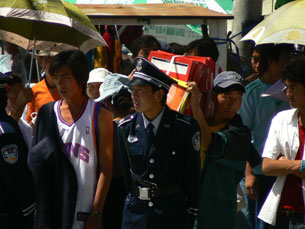




WASHINGTON—A television documentary filmed secretly in Tibet has been honored in a competition recognizing the work of freelance cameramen and camerawomen who gather news in “regions where it is difficult to operate.”
The competition, the Rory Peck Awards, is sponsored by the Rory Peck Trust, an independent London-based charity set up in 1995 to provide help to freelance newsgatherers and relatives of those killed, injured, or persecuted in the course of their work.
The Impact award, the category in which the film “Undercover in Tibet” was a competitor, is given “for freelance footage which raises humanitarian issues and has had an impact internationally or contributed to a change in perception or policy.”
The documentary was one of the top three selected for consideration at the annual event, held on Nov. 13 at the British Film Institute in London.
“Undercover in Tibet,” produced by cameraman Jezza Neumann and interviewer Tash Despa, was filmed over three months from late April 2007. It was first broadcast on Britain’s Channel 4 “Dispatches” program on March 31 this year.
“Once I met Tash and learned about the Tibetan cause, I knew how important this film could be,” Neumann said in an interview. “I feel this film is incredibly valuable, as it is video documentation of issues the Chinese are trying to say don’t exist.”
To make their film, Neumann and Despa traveled through Tibet by car, dodging Chinese police and security patrols and speaking to ordinary Tibetans.
Protecting sources

Painful lives
Another nomad, interviewed inside his bleak concrete apartment, describes high rates of alcoholism and depression among the town’s 300 families.
“We live in terror,” he says.
At another point in the film, the former prisoner, who had been immersed in water by his jailers and subjected to electric shock, breaks down part-way through his interview. “I’m less than half the man I was before the Chinese tortured me,” he says.
Tash Despa, a former Tibetan refugee and now a British citizen, conducted the interviews in his native language. He said that he had been asked by a friend on behalf of the British production company True Vision if he would go back into the region to help make the documentary.
“This was a really good chance to show the world what happened in Tibet, to bring the true story out of Tibet,” Despa said. "So I said, ‘Let’s do it!’”
Despa said that he and Neumann flew first into Hong Kong, where they received a visa, and then flew on into Tibet.
“We went all over Tibet: Lhasa, Amdo,” said Despa, who fled Tibet’s northeastern Amdo region himself in 1996. “We couldn’t go to Kham, because we couldn’t find any contacts to meet with.”
Despa said he hopes that audiences viewing the film will “put pressure on their governments to help Tibet.”
The annual Rory Peck Awards provide a platform for filmmakers to “get their stories out, and to get their point of view out,” said Tina Carr, director of the London-based Rory Peck Trust.
“Lots of people get to see all this, and we get a lot of inquiries. And very often, broadcasters who didn’t know about these films see them and want to show them.”
“I’m absolutely certain [this] will happen with Jezza’s piece,” she said.
Reported in Washington by Richard Finney. Edited and produced for the Web by Sarah Jackson-Han.